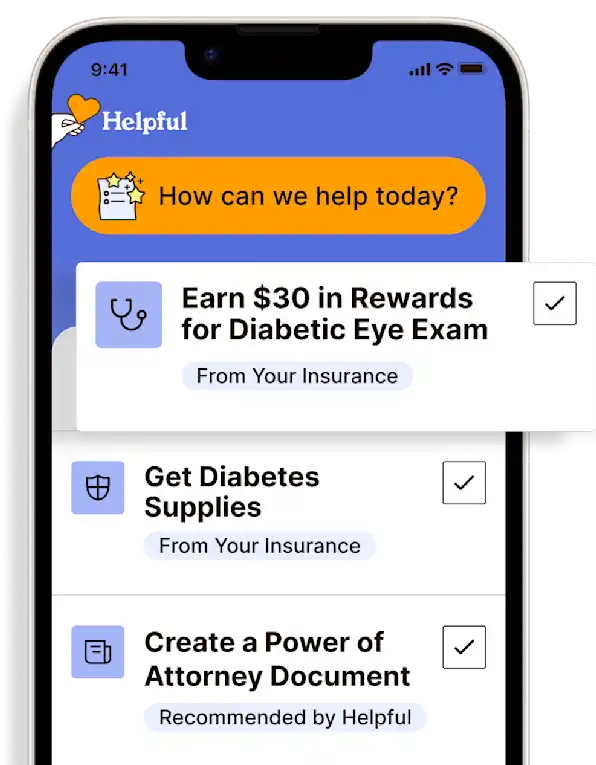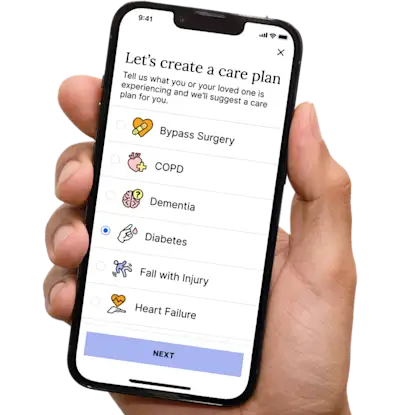Original Medicare (Parts A & B): Yearly "Wellness" Visit
"An apple a day keeps the doctor away." Good advice, but we should still see our provider regularly - whether healthy or ill.
Access all my benefitsGet insurance benefits, legal documents, and medical records in one place
How To Receive
Details on how to apply
Schedule an appointment with a primary care provider. Find a primary care provider near me
Attend the appointment and complete the wellness check.
Work with the provider to review and update the care plan(s).
Engage in any follow-up recommended by the provider.
For more information on Medicare benefits and coverage, call 1-800-MEDICARE (1-800-633-4227) or visit the Medicare Benefits Website. TTY users, call 1-877-486-2048.
Get more support and guidance on insurance benefits, medical records and legal forms.
Helpful brings together your insurance benefits, legal documents, and medical records in one personalized place — so you always know what you have, and never have to search again.

The annual wellness visit can identify any problem areas and detect abnormalities in the body or blood that need further assessment and treatment. Yearly check-ups are essential to disease prevention and management by identifying what’s working and what’s not before major issues develop.
Annual wellness visits help to develop or update a personalized prevention and management plan (often called a “care plan”) based on current health and risk factors. It is important to recognize that a lot can change, for better or worse, over the course of 12 months, and not all changes are obvious. Changes in blood pressure, blood sugar, kidney function, hearing or vision, weight, pain, digestion, and many more, often don’t come with signs or symptoms, whether improving or worsening.
Annual wellness visits are also a good time to review all prescription and over-the-counter medications, especially to determine and discuss any potential drug-drug or food-drug interactions, any side effects, if the medications are working as they should, if any changes need to be made, and explore what’s called “deprescribing,” which is the planned process of reducing or stopping medications that may no longer be of benefit or may be causing harm.
*Note that the first annual wellness visit cannot take place within 12 months of the “Welcome to Medicare” preventive visit.
What it is
The provider will request the completion of a questionnaire, called a “Health Risk Assessment,” as part of this visit. Answering these questions helps develop a personalized prevention plan for health and well-being, and to get the most out of your visits. The wellness visit may include:
Routine measurements (like height, weight, and blood pressure).
A review of medical and family history.
A review of current prescriptions, as well as over-the-counter drugs and supplements.
Care plan development or update.
Personalized health advice.
Referral to a specialist, if needed.
Advance care planning.
Help with understanding more about available and appropriate community resources.
Cognitive assessment and care plan services
The provider will also perform a cognitive assessment to look for signs of dementia, including Alzheimer’s disease. Signs of cognitive impairment include trouble remembering, learning new things, concentrating, managing finances, and making decisions about everyday life. Conditions like depression, anxiety, and delirium can also cause confusion, and these are important to differentiate from dementia.
If the provider thinks there is cognitive impairment, Medicare covers a separate visit with the primary care provider or specialist to do a full review of cognitive function, establish or confirm a diagnosis, and develop a care plan. It is advisable that the member brings someone with them (spouse, close friend, caregiver) during a cognitive assessment to help provide information and answer questions.
Substance use
The provider will also evaluate potential risk factors for substance use disorder and refer the member for treatment if needed. If the member uses opioid medication, the provider will review the pain treatment plan, share information about non-opioid treatment options, and refer them to a specialist, as appropriate.
Advance care planning
Medicare also covers voluntary advance care planning as part of the yearly wellness visit. This is planning for care the member would get should they become unable to speak for themselves. As part of advance care planning, they may choose to complete an advance directive. This is an important legal document that records their wishes about medical treatment at a future time if they aren't able to make decisions about their care. You and your loved one can talk about an advance directive with their primary healthcare provider and they can help with completing the forms.
You or your loved one should carefully consider who they want to speak for them and the directions they want to be given. Everyone has the right to carry out their plans as they choose without discrimination based on age or disability. They can update their advance directive at any time.
Additional tests and services
If the provider performs additional tests or services during the same visit that Medicare doesn't cover under this preventive benefit, members may have to pay coinsurance and the Part B deductible may apply. If Medicare doesn't cover the additional tests or services (like a routine physical exam), members may have to pay the full amount.
Technology for Health Tasks. Mental Health for the Tough Stuff.
Helpful connects your medical records, insurance, and caregiving tasks automatically. And when you need more than logistics, a therapist is here to guide you.
In-Network and Covered
For Individuals, Couples and Families
HIPAA Compliant, Data Stays Private


Healthcare Tasks Simplified

From syncing records to spotting drug interactions, Helpful does the heavy lifting, turning complex health info into clear tasks and showing you benefits you can actually use, giving you clarity and control over your care.

In-Network Mental Health

Our licensed therapists are here to support you and your loved ones through stress, burnout, and life’s hardest moments, with an inclusive, compassionate approach that works with most insurance plans.

Create Legal Documents

Plan ahead by creating will, trusts, advance directives and more, that ensure your wishes are honored in the event you can’t speak for yourself -with Helpful guiding you every step of the way.